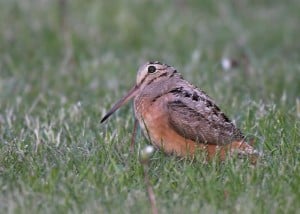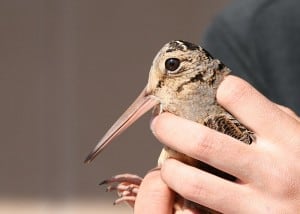With monikers such as pop-eyed shot dodger, bogsucker, sky dancer and timberdoodle, the American Woodcock may have the most evocative nicknames of any bird. This game specie’s real claim to fame, however, is its spring courtship flight, in which males fly high overhead on twittering wings before returning sharply to the ground to resume their unique “peenting” calls. The American conservationist Aldo Leopold famously wrote that such dawn and dusk “sky dances” are a living “refutation of the theory that the utility of a game bird is to serve as a target, or to pose gracefully on a slice of toast.” Although woodcock can be found all over the Kawarthas, many people spend their whole life never knowing such a bird exists. What a shame this is, because the sight and sound of displaying woodcock is a true spectacle of spring.
A unique bird
Woodcock arrive back in late March from wintering grounds in the southeastern states. Their arrival more or less coincides with the thawing of the soil, which frees up their favourite food – earthworms. Migrating birds will sometimes show up in suburban backyards and create quite a stir as people try to figure out the identity of the rather ridiculous-looking visitor. The woodcock is indeed quite comical, with its bizarre anatomy and even stranger behaviours. It is similar in size and shape to a starling, but with a mottled colouration of blacks, browns, tans and whites, which provide near-perfect camouflage against the dead leaves, and twigs of the forest floor. Evolution has also provided the woodcock with very large eyes, located high and well back on the head. The size and placement allows the bird to see in front, behind and even above, affording a view of approaching predators such as domestic cats, hawks, owls and coyotes. This adaptation is extremely important because woodcocks spend a lot of time with their head down and their bill deep in the mud. The males also draw a lot of attention to themselves during their courtship displays.
Like many shorebirds, the woodcock also has a long bill – as long as your middle finger – with which it probes deeply into soil for earthworms. The sensitive, flexible bill tip can feel a worm in its underground burrow and then open to grab it. This feat is nearly impossible for other birds.
The woodcock’s walking style is also quite different from other birds. It tends to amble slowly along, all the while rocking its body back and forth. Its head, however, remains motionless. This strange gait is accompanied by a kind of foot-stomping, which is thought to cause worms to move around in the soil, thereby making them more easily detectable
Sky Dance
The woodcock behavioural claim-to-fame, however, is its amazing courtship flight or “sky dance.” From late March until early June, the male performs one of the most fascinating courtship spectacles in nature, in which he goes to extraordinary lengths to show his fitness and virility to females. The sky dance is performed over openings known as singing grounds. Beginning in the near-dark evening twilight, the male starts to “peent.” The sound is reminiscent of a buzzy, nasal toy horn. As darkness falls, the peents become more numerous until, all of a sudden, the bird bursts into the air and flies upwards in wide circles.
Because the woodcock’s three outer wing feathers are stiff, narrow and spread apart during flight, the air rushing through causes them to vibrate, producing a high, mechanical, twittering sound. After reaching a height of about 100 metres (300 feet), the twittering becomes intermittent, and the bird soon begins a zigzag descent. A third sound is then produced as the woodcock starts singing liquid, kissing notes – just in case the flight itself was not enough to impress the hard-to-please female! The kissing notes grow louder and louder as he approaches the ground, but then cease completely for the final portion of the descent. The bird usually lands almost at the same spot from whence he took off. He then walks stiff-legged in the direction of the nearby female, wings stretched vertically. Soon after, he begins peenting once again. A few minutes later, the poor bird—probably close to exhaustion — launches into yet another flight. Woodcock will display for up to an hour at dusk and dawn and even through the night if there is a full moon. Click here for a YouTube video of the sky dance.
The males will mate with any female impressed with his display. However, there is a catch. He provides no help with nest-building, incubation of the eggs or with brood rearing, but simply turns his attention to attracting other females. All of the woodcock’s various sounds can be heard by visiting allaboutbirds.org. To see and hear a great video of the aerial display, go to YouTube and search for “American Woodcock Air Dance”.
Seeing woodcock
American Woodcock are birds of habitats that are in transition, such as abandoned farmlands reverting to forest. They also frequent second-growth forest edges and low, damp, brushy fields of alder, poplar, cedar, etc. One place to see them is from the parking lot at the Trent Wildlife Sanctuary on University Road. If the birds are not displaying here, cross the road to the canal side and walk straight ahead to the brushy field along the Morton Family Trail, being careful not to turn left up the hill. Listen carefully for the peenting sound. Because the darkening sky makes it difficult to actually see the woodcock in flight, try to face west. In this way, the bird will stand out against the lighter, western sky. After it takes off, you can move a little closer to the take-off point. By remaining quiet and staying low, it is often possible to end up as close as two metres to the bird when it lands.
Woodcock also garner attention in the fall, because they are one of the few shorebirds that is hunted for sport. They often flush right from under the hunter’s feet and fly at “jet-propelled speeds on a corkscrew trajectory” as local outdoor writer Jack Davis once wrote. Another author described their flight as ‘the shortest distance between two points which includes two zigs, a zag and at least one drastic change in altitude.”
So, what is the value of this odd bird? For a birder, the woodcock is simply thrilling to watch and a great species to add to the day list; for the more scientifically-inclined, the bird’s many adaptations exemplify the power and wonder of evolution; for people who are simply interested in natural history, the woodcock’s amazing behaviour prompts fascination and sheer aesthetic enjoyment; and for hunters, the bird represents not only a delicious meal but also the pleasure of being out on a crisp autumn day and shooting such a challenging target. This multiplicity of values is true about nature as a whole. As Yale scholar and environmentalist Stephen Kellert writes, when viewed from any single value, the woodcock – and species in general – can be easily marginalized and rendered irrelevant. Yet when seen in a broader spectrum of relationships…this bird becomes another portal for deepening our sense of selfhood and membership in a broader community, enriching both our personal and collective lives.
Spring Wildlife Walks
Each Sunday morning in April and May, the Peterborough Field Naturalists are holding a spring wildlife walk. Meet at 8 a.m. at the parking lot of the Peterborough Zoo. The outings last for about three hours and are lead by a variety of local naturalists. They will be taking participants to different locations in the Peterborough area. Although the focus is on birds, wildflowers, trees and other aspects of spring in the natural world will also be enjoyed. Everyone is welcome. For additional information, contact Martin Parker at 705 – 745 – 4750 or Paul Elliott at 705-740-0501.

